'ZDNET Recommends': What exactly does it mean?
ZDNET's recommendations are based on many hours of testing, research, and comparison shopping. We gather data from the best available sources, including vendor and retailer listings as well as other relevant and independent reviews sites. And we pore over customer reviews to find out what matters to real people who already own and use the products and services we’re assessing.
When you click through from our site to a retailer and buy a product or service, we may earn affiliate commissions. This helps support our work, but does not affect what we cover or how, and it does not affect the price you pay. Neither ZDNET nor the author are compensated for these independent reviews. Indeed, we follow strict guidelines that ensure our editorial content is never influenced by advertisers.
ZDNET's editorial team writes on behalf of you, our reader. Our goal is to deliver the most accurate information and the most knowledgeable advice possible in order to help you make smarter buying decisions on tech gear and a wide array of products and services. Our editors thoroughly review and fact-check every article to ensure that our content meets the highest standards. If we have made an error or published misleading information, we will correct or clarify the article. If you see inaccuracies in our content, please report the mistake via this form.
You can upgrade your old PC to Windows 11 - even if Microsoft says it's 'incompatible'. Here's how



On October 14, 2025, Microsoft will stop delivering security updates to your Windows 10 PC unless you're willing to pay an exorbitant price to join the Extended Security Updates program.
If you try to upgrade to Windows 11 on a PC over a few years old, you'll be told, in no uncertain terms, that your old PC doesn't qualify, because its CPU isn't on the official list of compatible processors. Microsoft has made it abundantly clear that it will not revise those requirements. You will also hit roadblocks if your PC doesn't have a Trusted Platform Module (TPM) version 2.0.
Also: The Windows 10 clock is ticking: 5 ways to save your old PC in 2025 (most are free)
While that might be the official policy, as with everything Windows-related, it pays to read the fine print.
Those pesky restrictions prevent you from automatically upgrading to Windows 11 using Windows Update or the Windows 11 Installation Assistant. Yet there are two fully supported workarounds, as I document in ZDNET's Windows 11 FAQ.
Also: How to install Windows 11 the way you want (and sneak by Microsoft's restrictions)
If you're willing to perform a clean installation of Windows 11, you can boot from installation media and run Windows Setup. That option skips the CPU compatibility check completely. After the installation completes, you'll need to reinstall all your apps, restore your data files, and tweak settings to personalize your system preferences.
Want to avoid all that hassle? Follow these four steps.
How to upgrade your old 'incompatible' PC to Windows 11
1. Change one key in the Windows registry
You need to make one small change to the Windows registry, as documented in this Microsoft support document. This change tells the Windows 11 Setup program to skip the check for compatible CPUs and to allow installation on a PC with an older TPM (version 1.2). The usual warnings apply when working with the registry, of course, and I recommend you make a complete backup before proceeding.
Open Registry Editor (Regedit.exe) and navigate to the following key:
HKEY_LOCAL_MACHINE\SYSTEM\Setup\MoSetup
Select that key and then right-click in any empty space in the pane on the right. Choose the option to create a new DWORD value, AllowUpgradesWithUnsupportedTPMOrCPU, and set its value to 1. The result should look like this:
Use this registry tweak to override the Windows 11 CPU and TPM compatibility checks.
Click OK to save your change.
2. Download the Windows 11 ISO
On the PC you want to upgrade, go to the Windows 11 Download page (aka.ms/DownloadWindows11) and choose the option at the bottom of the page, "Download Windows 11 Disk Image (ISO) for x64 devices." Save the ISO file in your Downloads folder.
Also: Microsoft is changing how it delivers Windows updates: 4 things you need to know
Note that this is a big file. Depending on the speed of your internet connection, the download could take a while.
3. Mount the ISO file in File Explorer
After the download completes, open File Explorer and double-click the ISO file. Doing so mounts the file as a virtual DVD drive in its own folder.
4. Run Windows Setup
In File Explorer, find the Setup.exe file and double-click it to begin the upgrade. You'll see a stern warning about compatibility issues, but after you click OK on that dialog box, your upgrade should proceed without any serious issues. You'll have three options: you can keep your apps, settings, and files (Full Upgrade); keep your data files but start fresh with apps and settings (Keep Data Only); or start completely fresh (Clean Install).
Also: The best Windows laptops you can buy: Expert tested and reviewed
If you want more control over the upgrade process and aren't afraid to mess with creating custom installation media, you can use the free, open-source utility Rufus. My ZDNET colleague Lance Whitney has the full details in "How to install Windows 11 the way you want (and sneak by Microsoft's restrictions)."